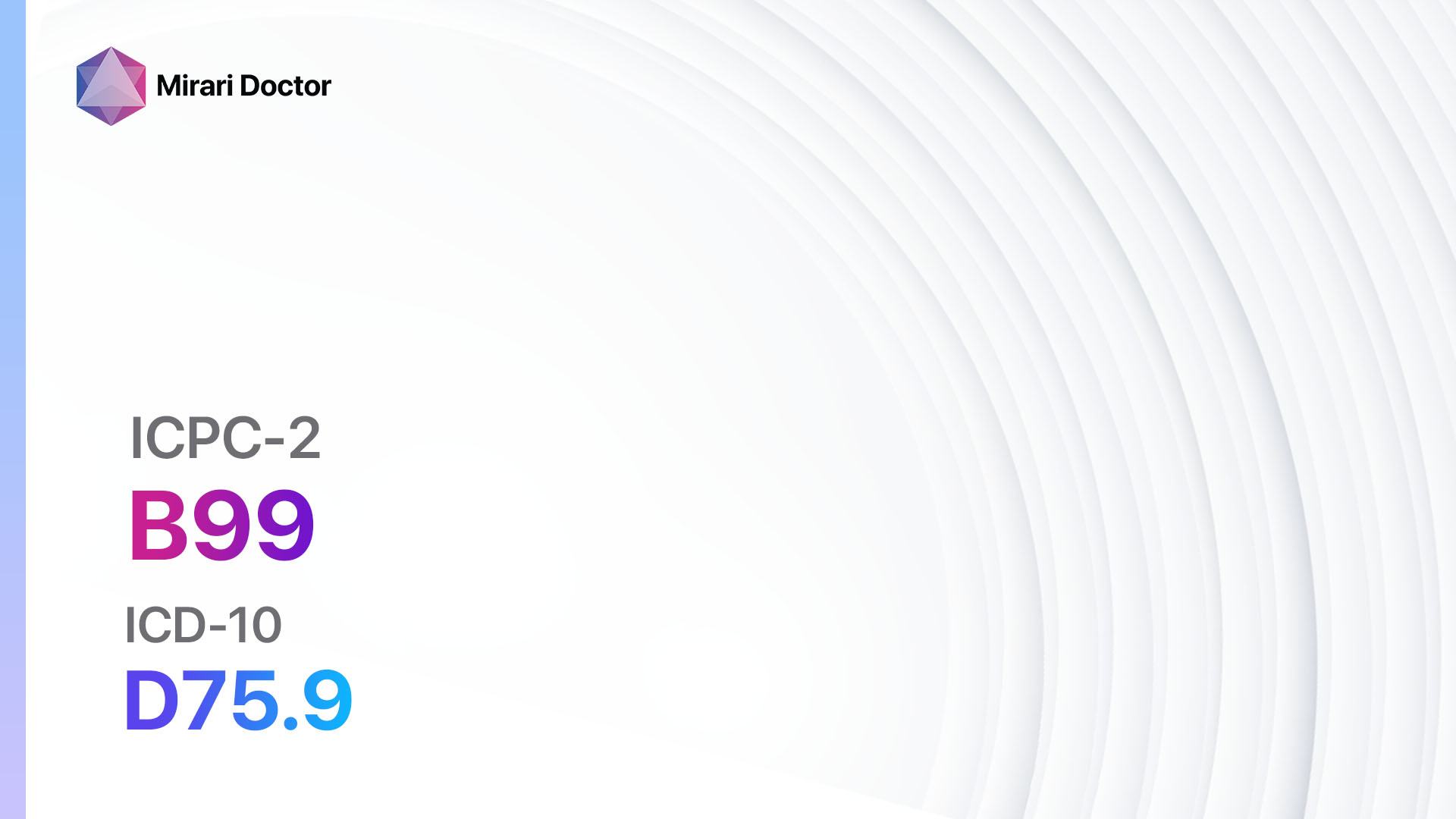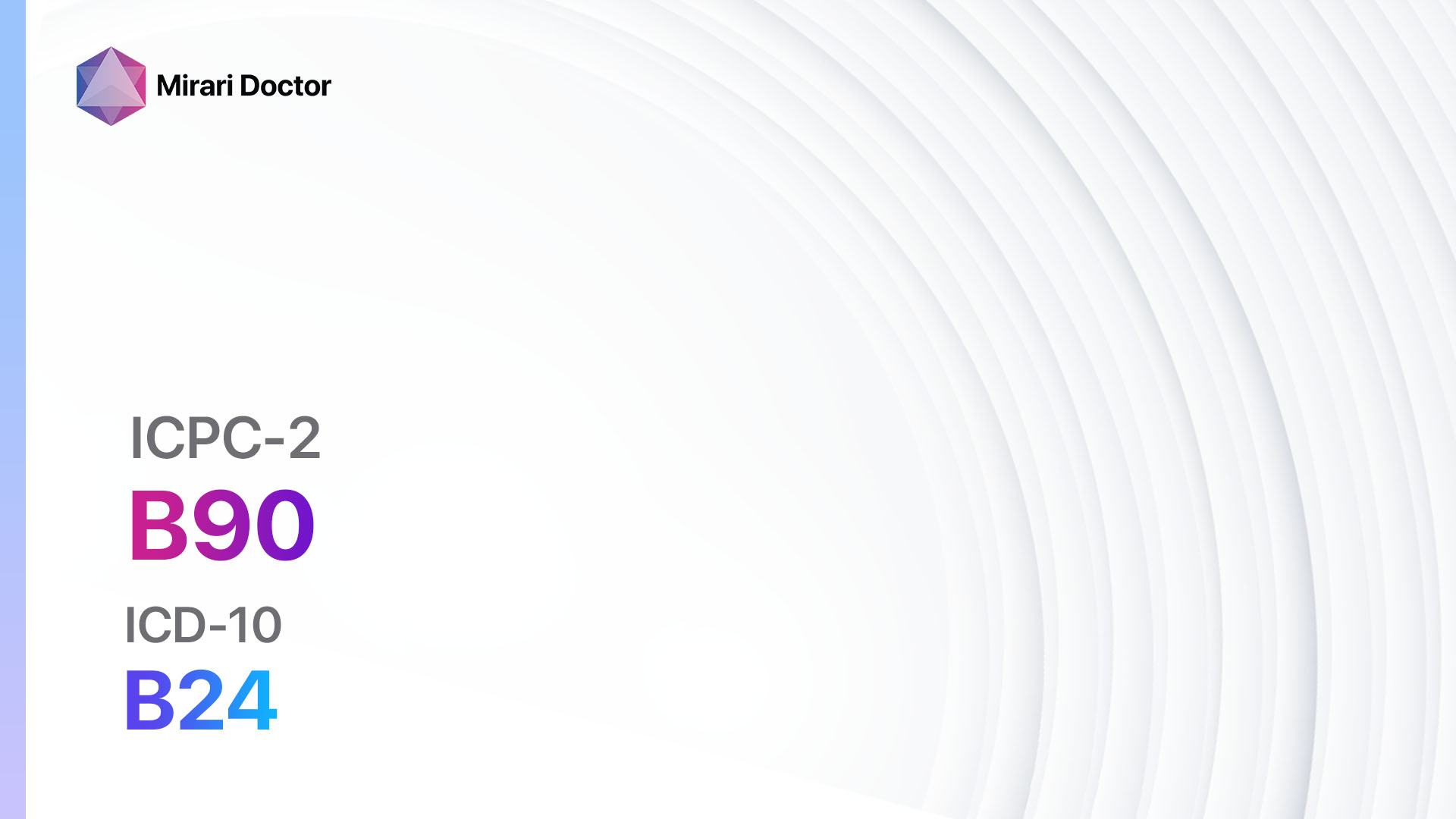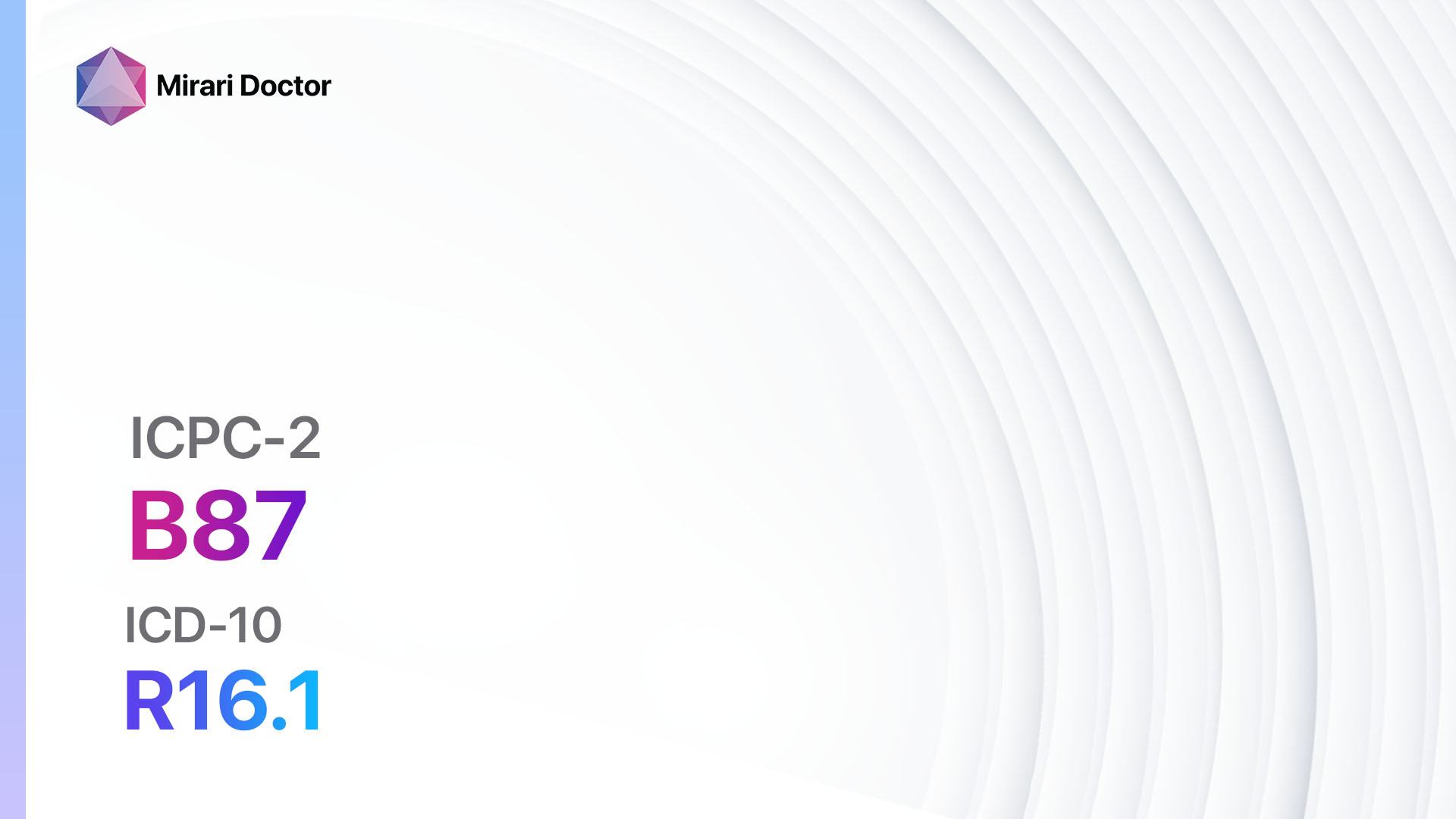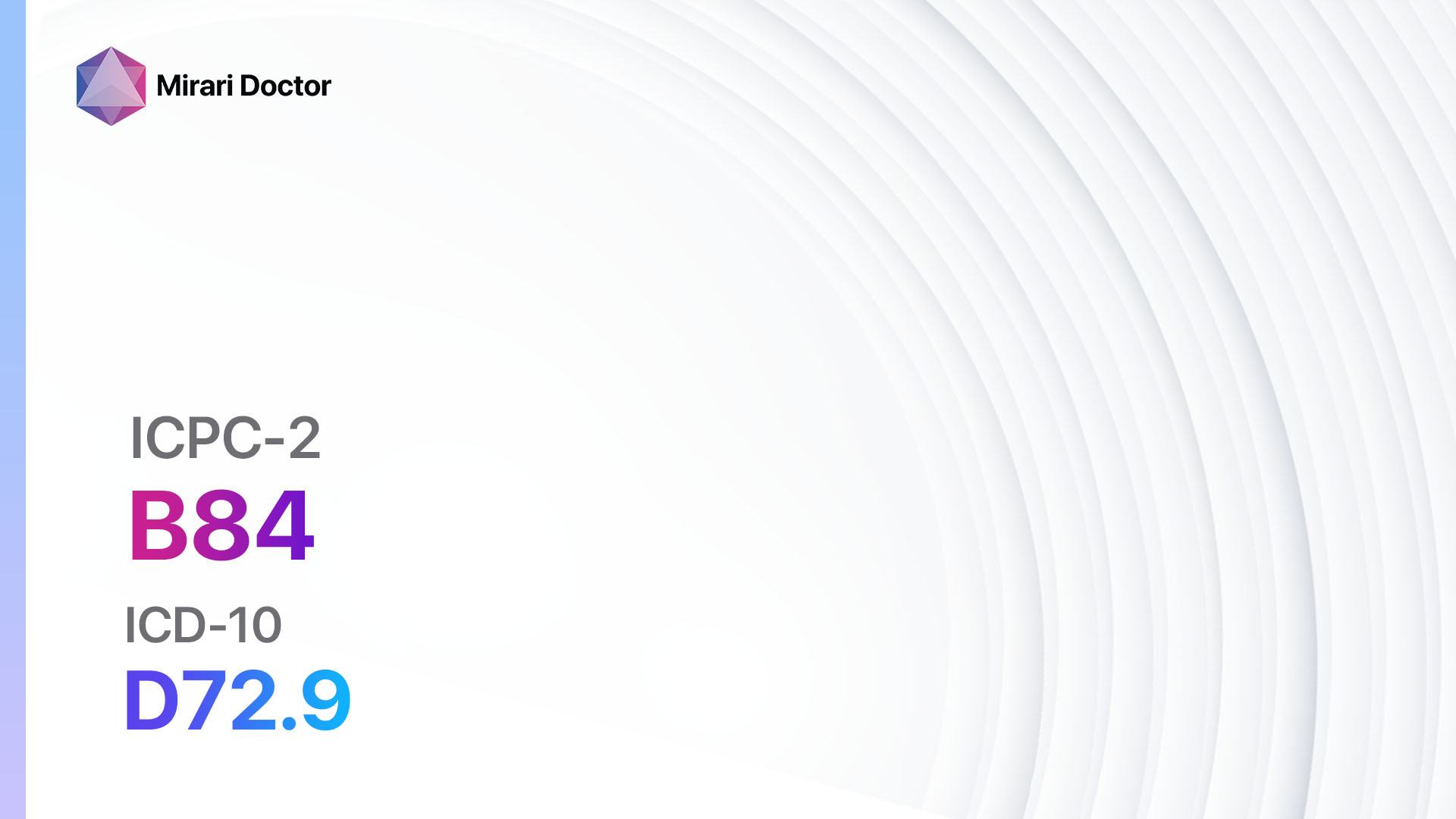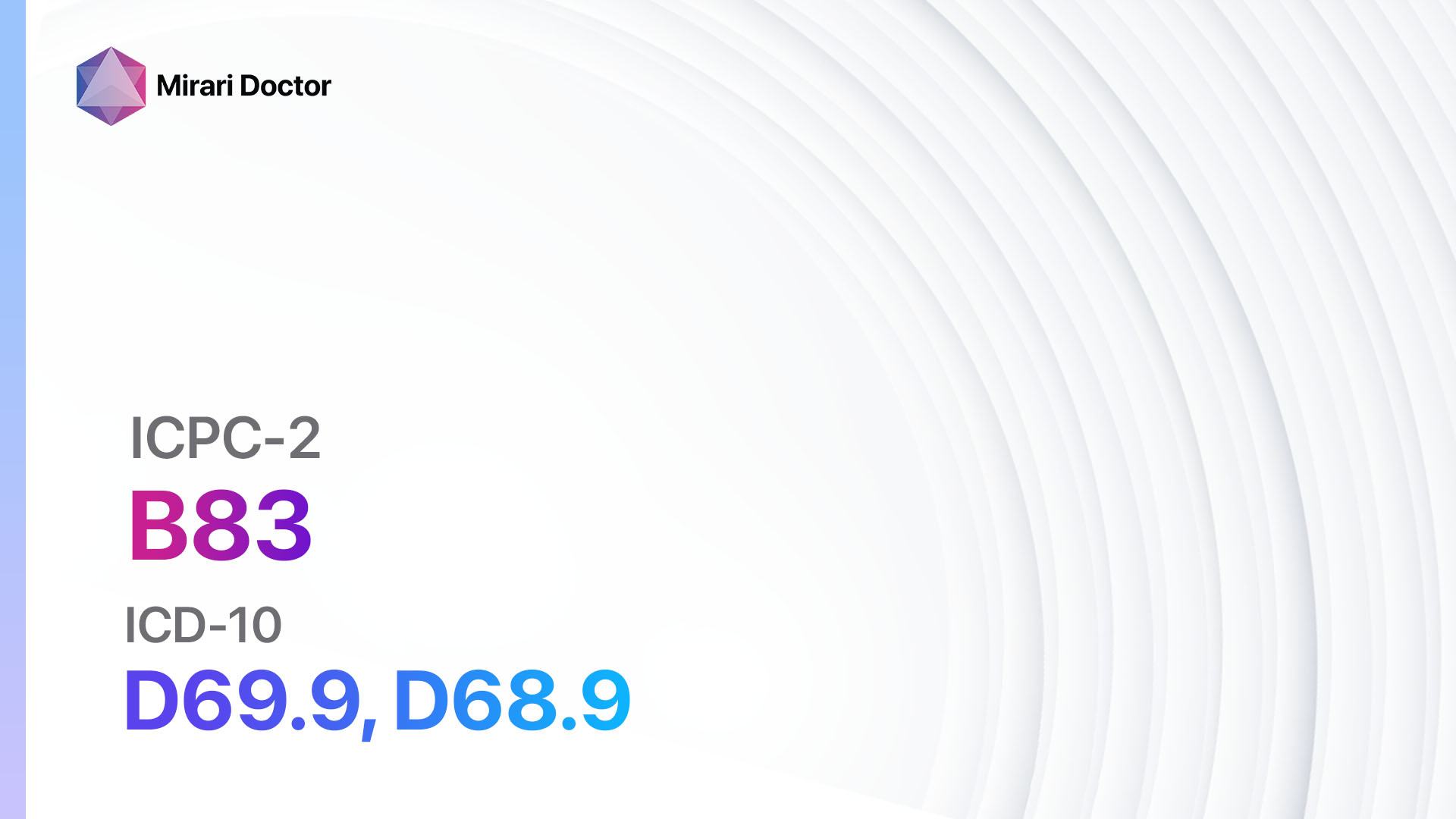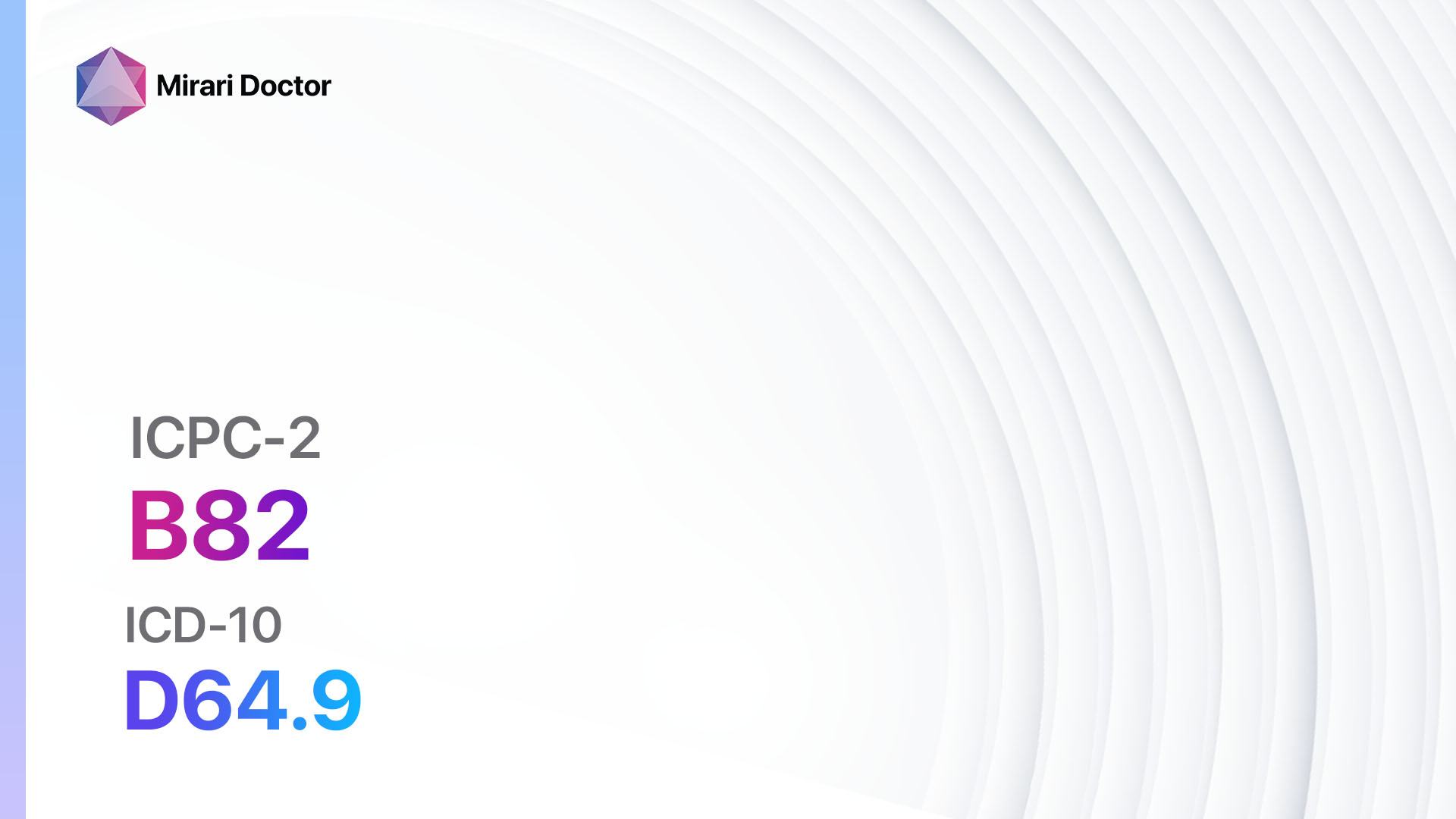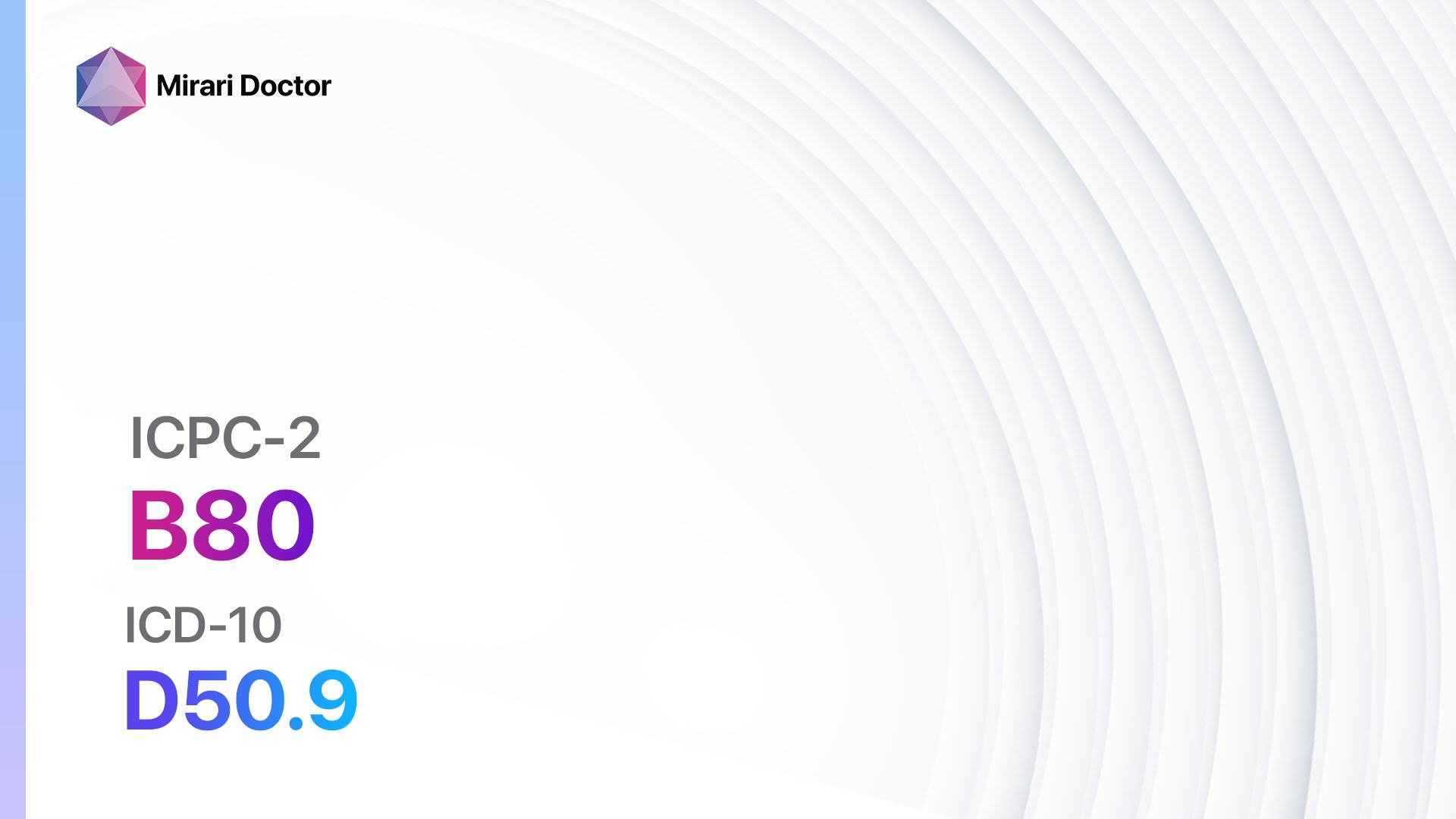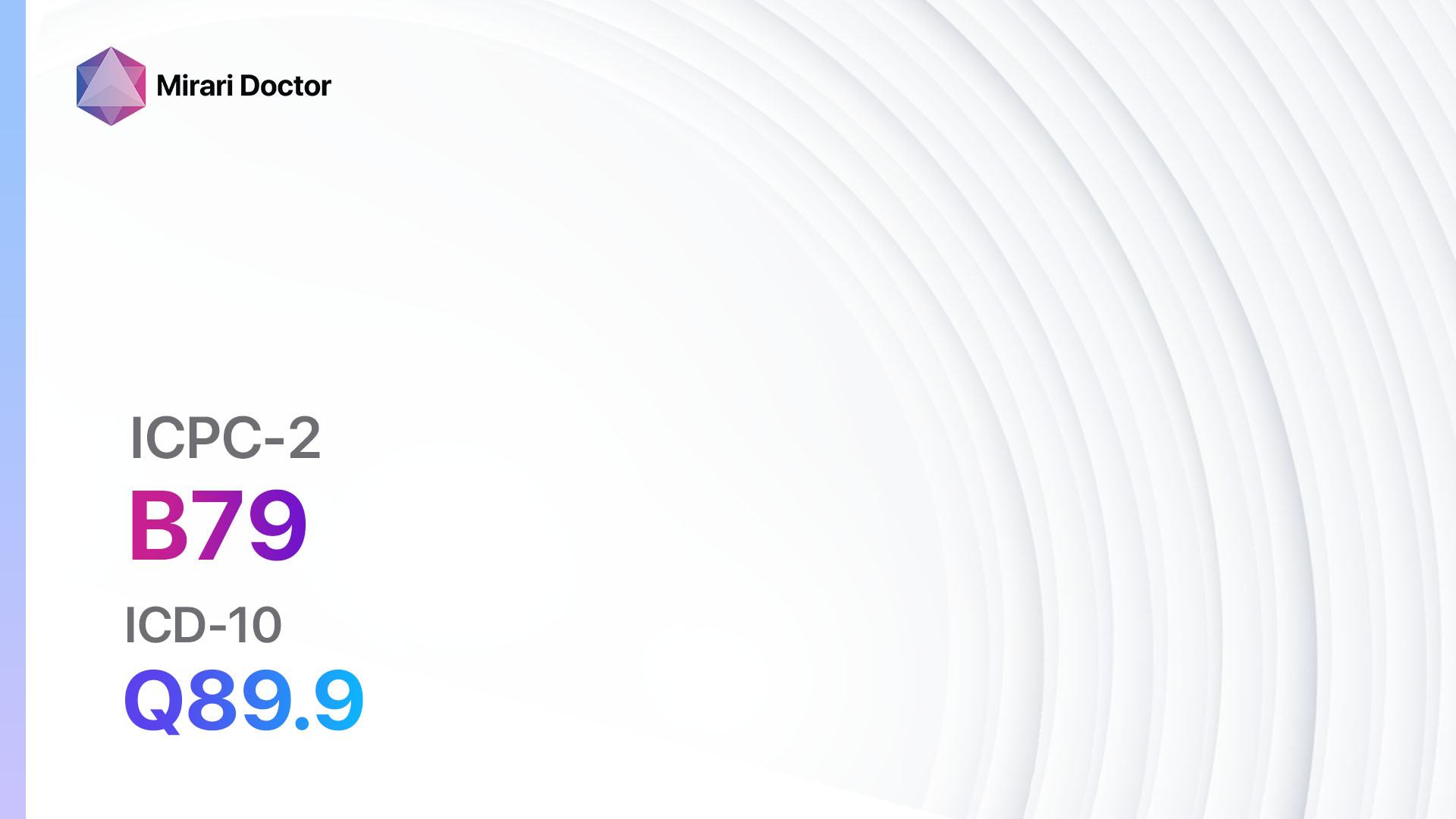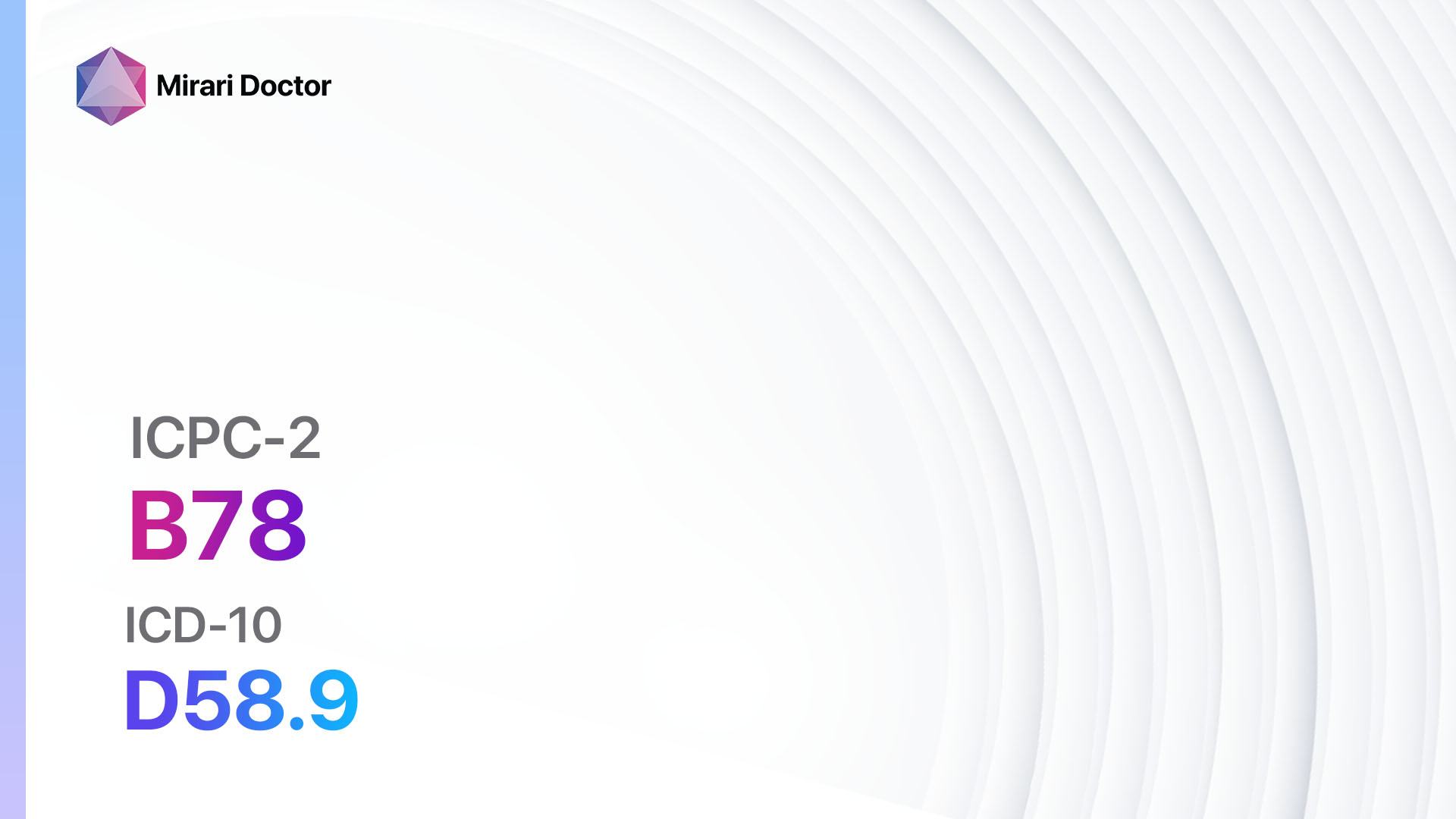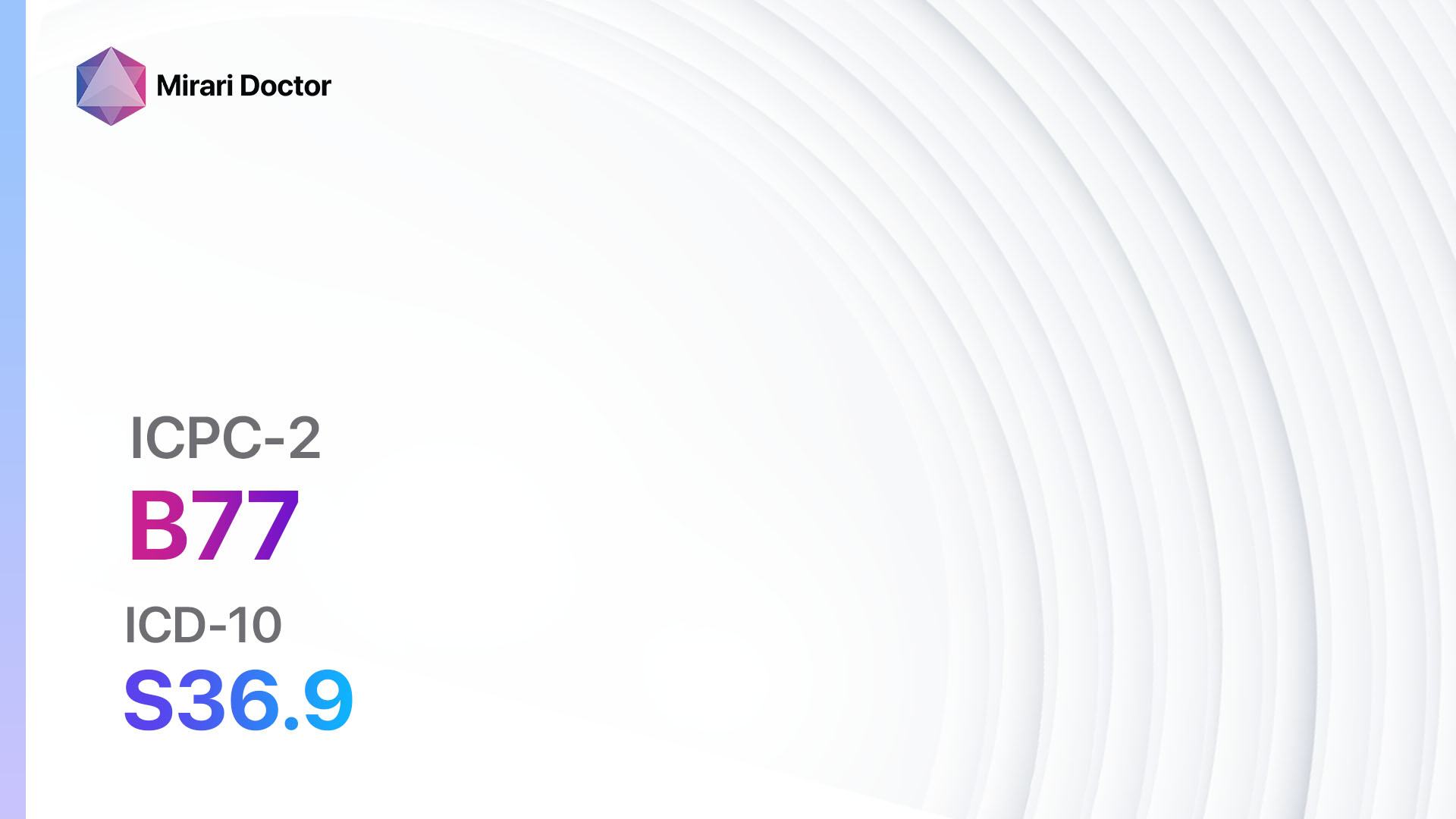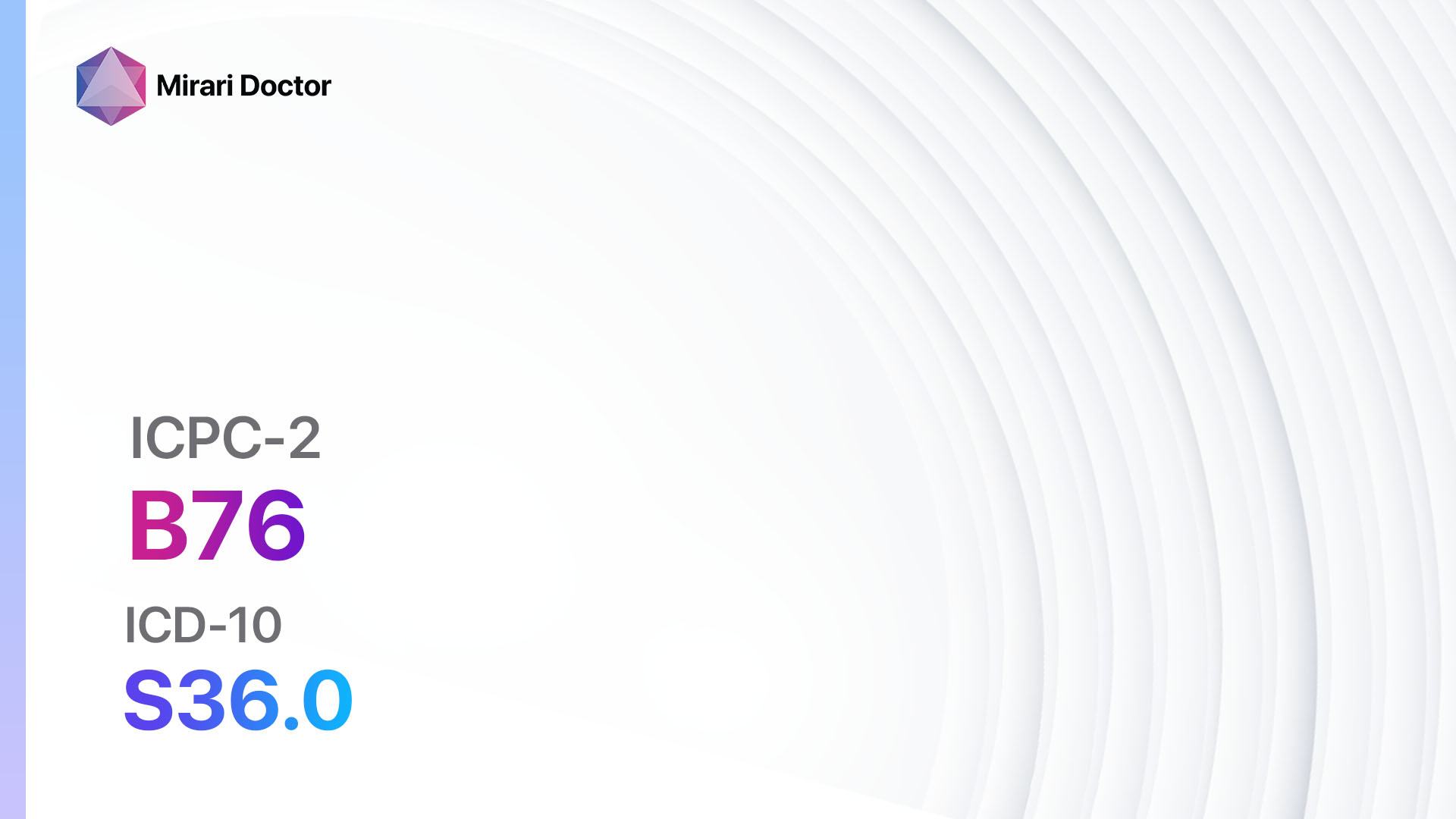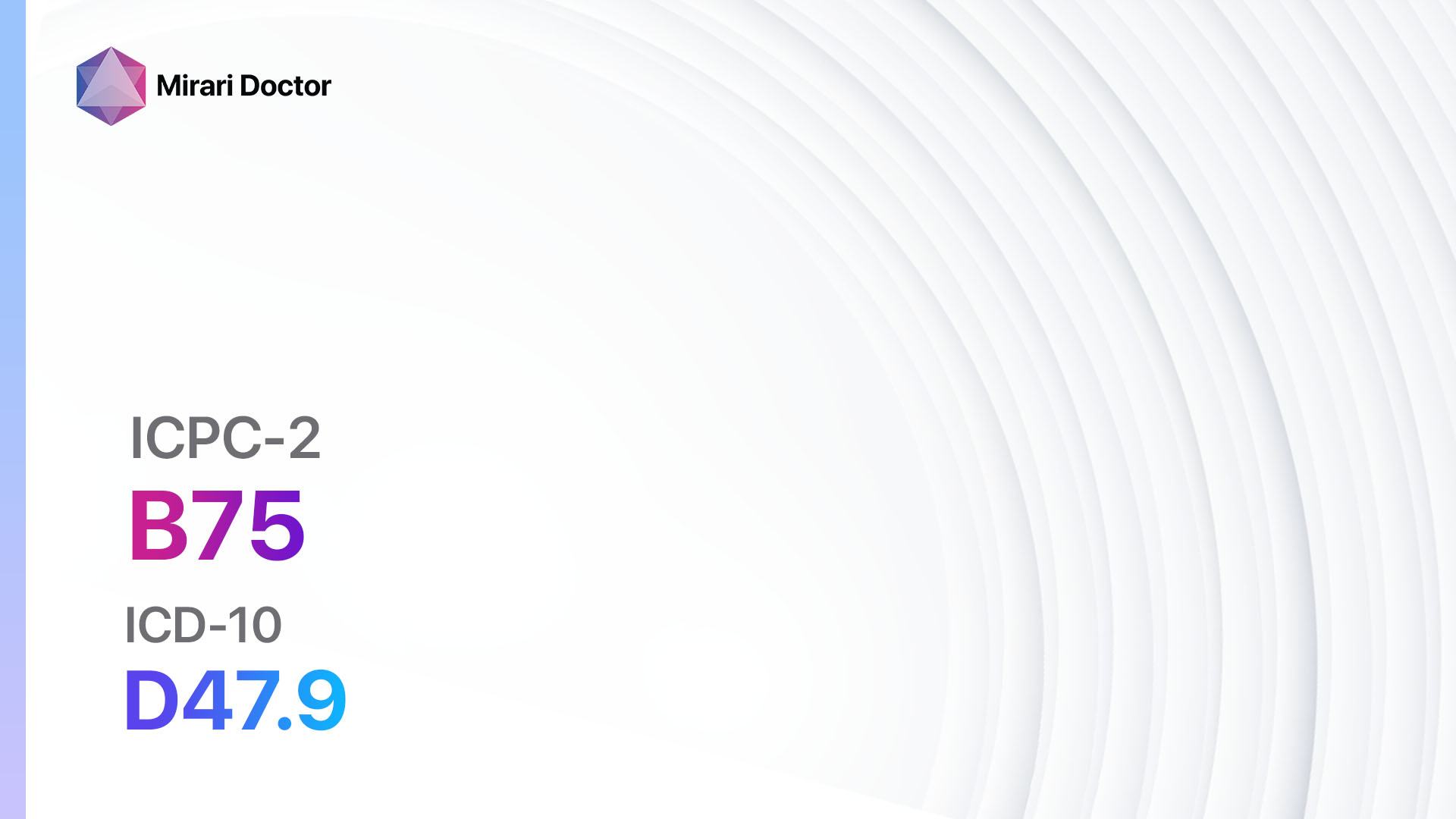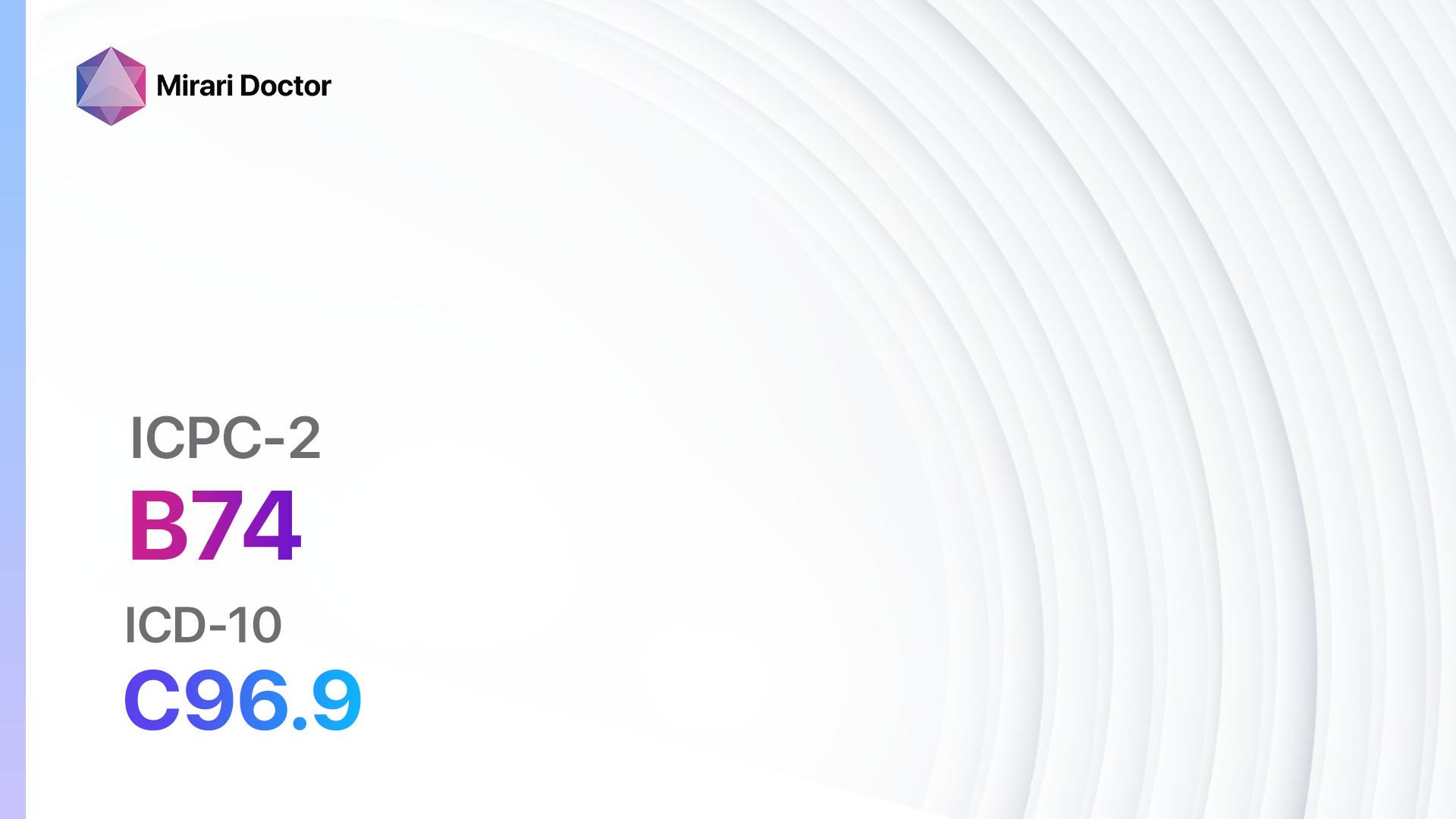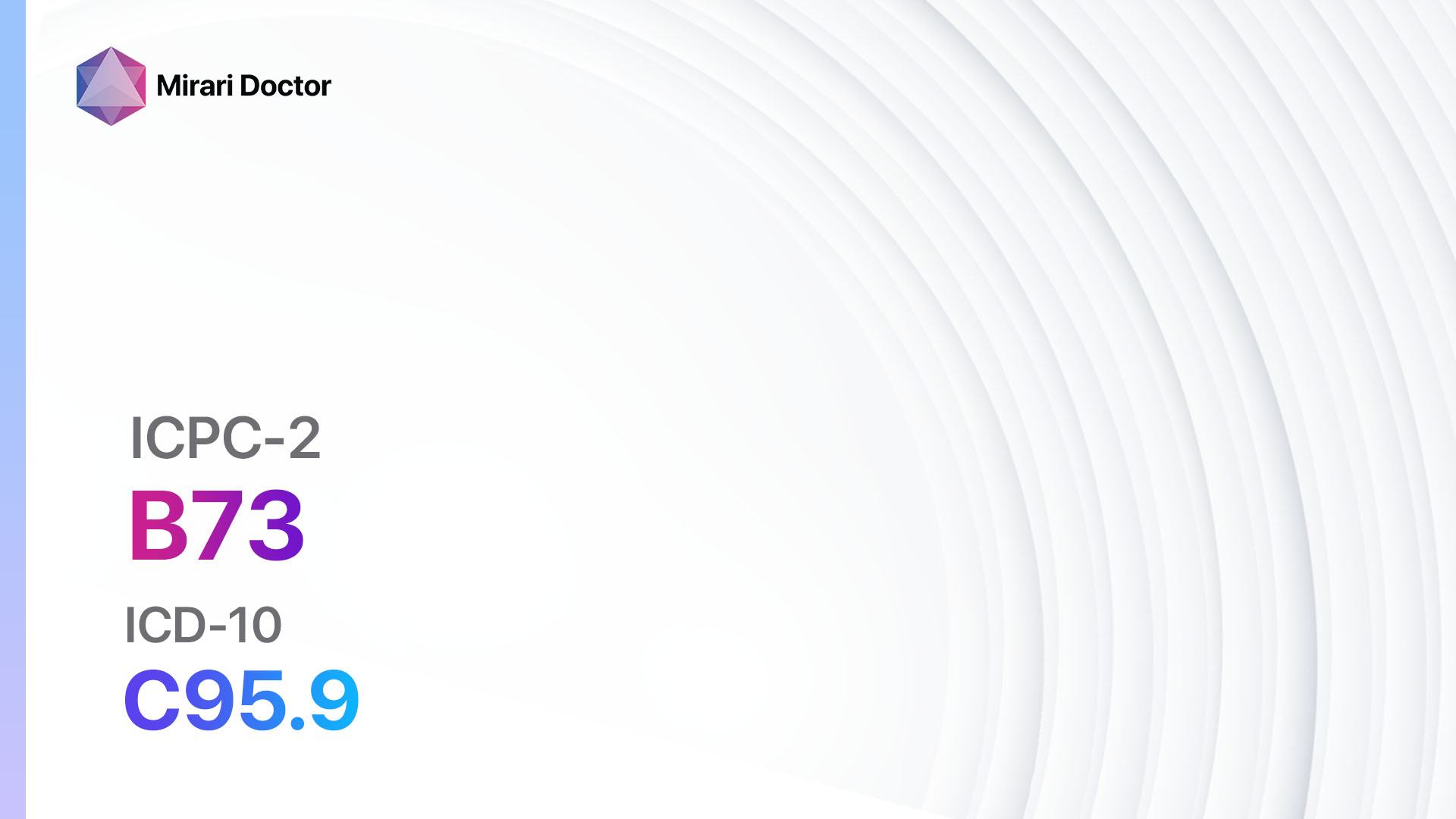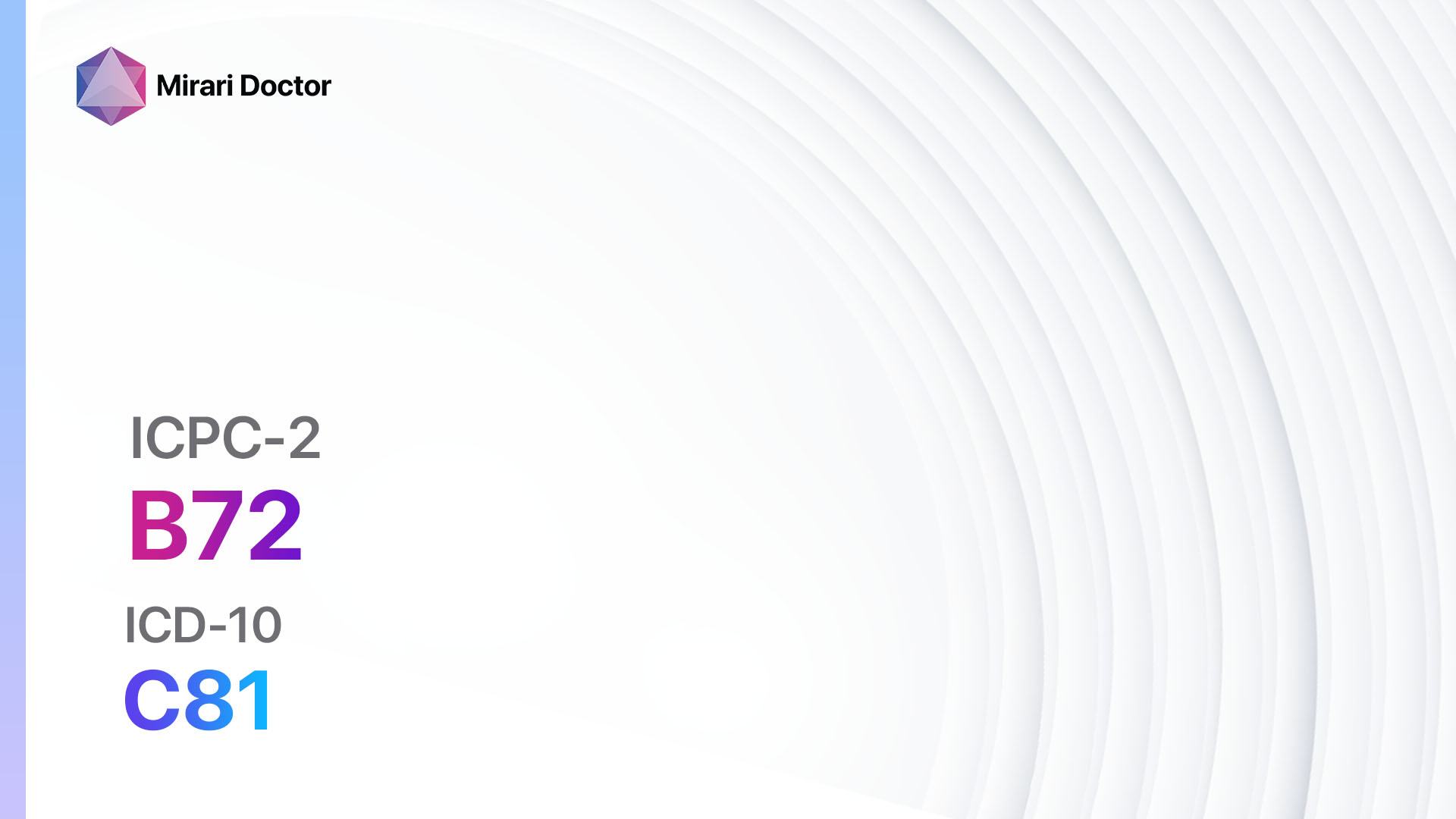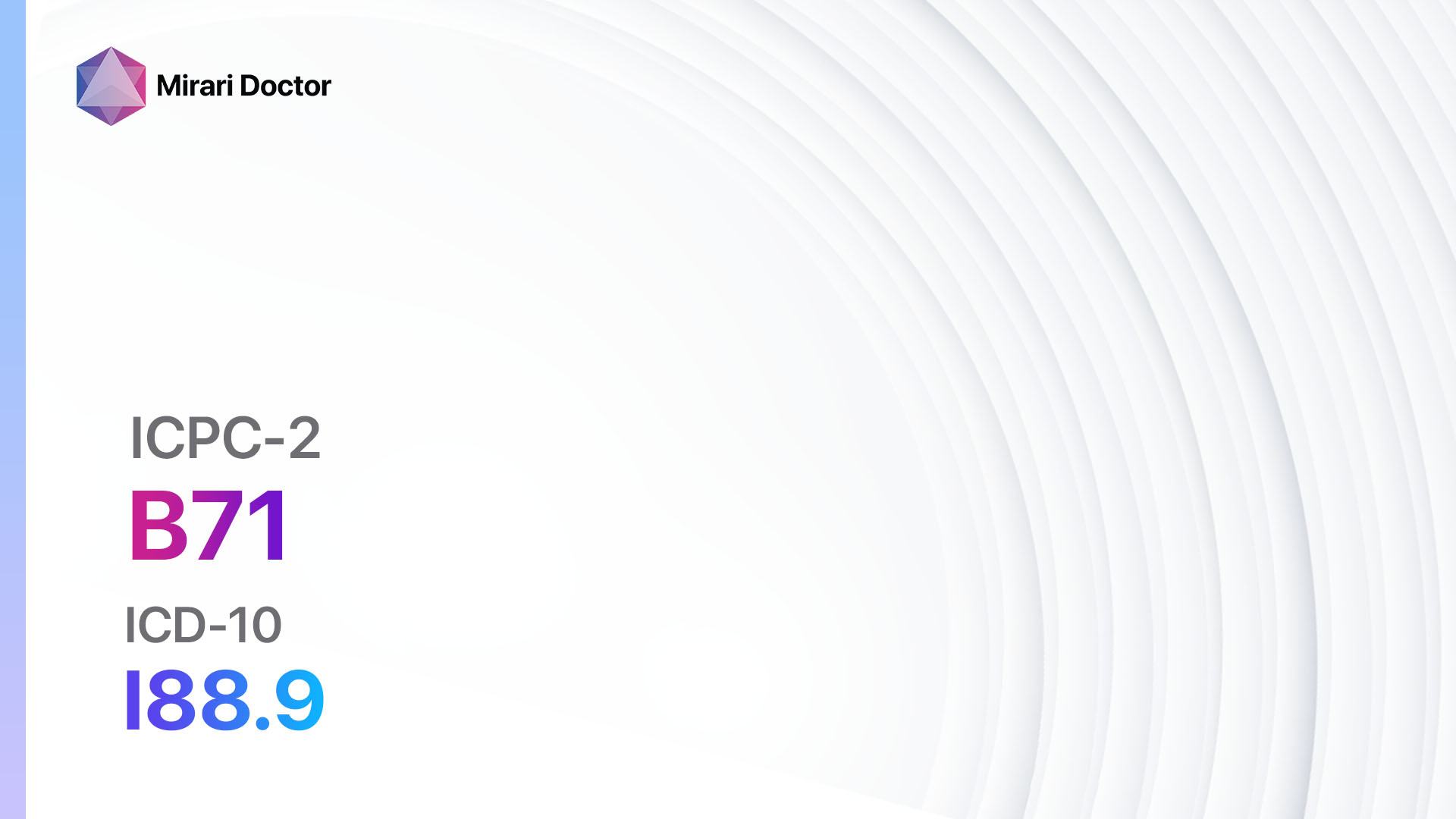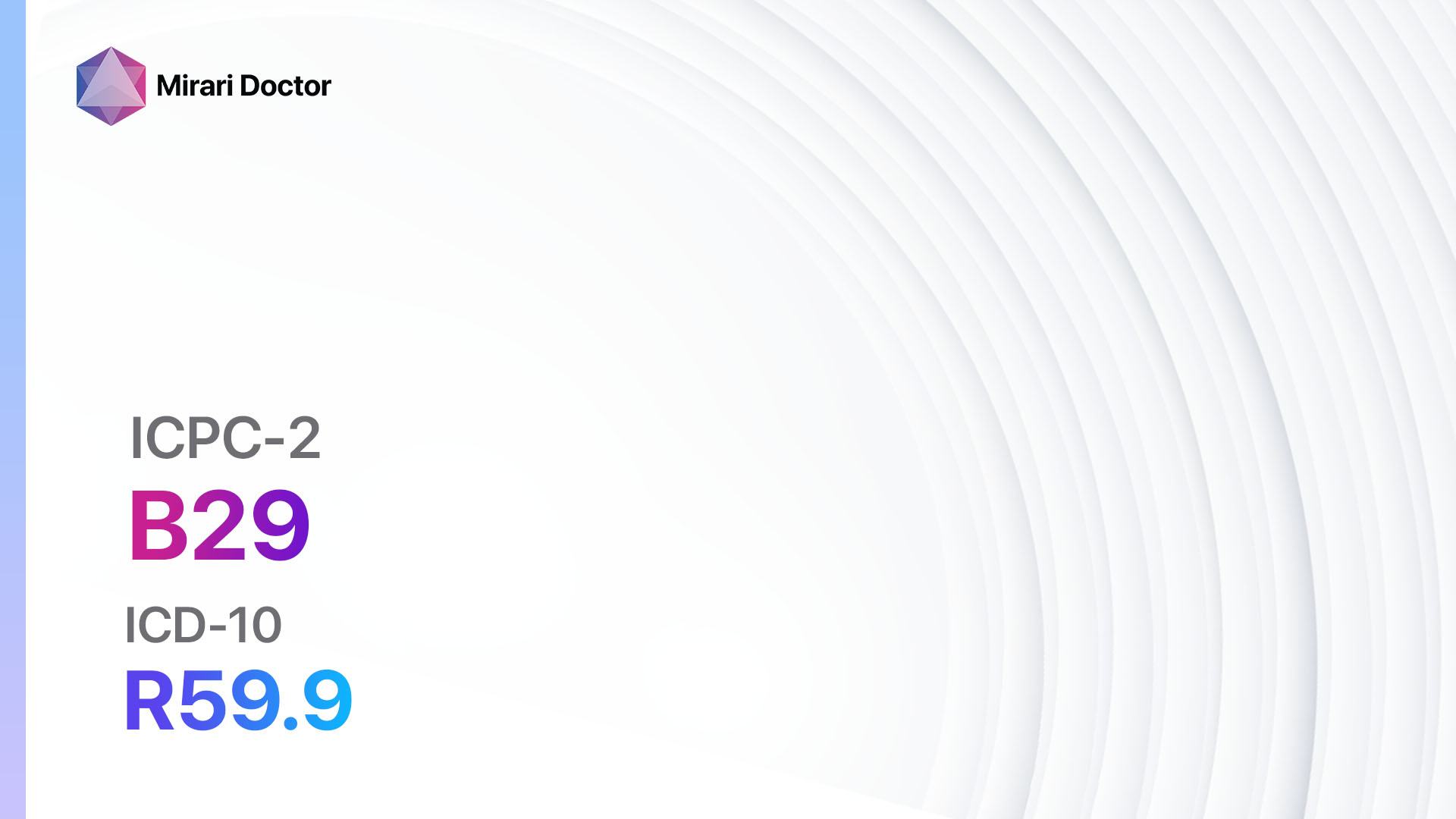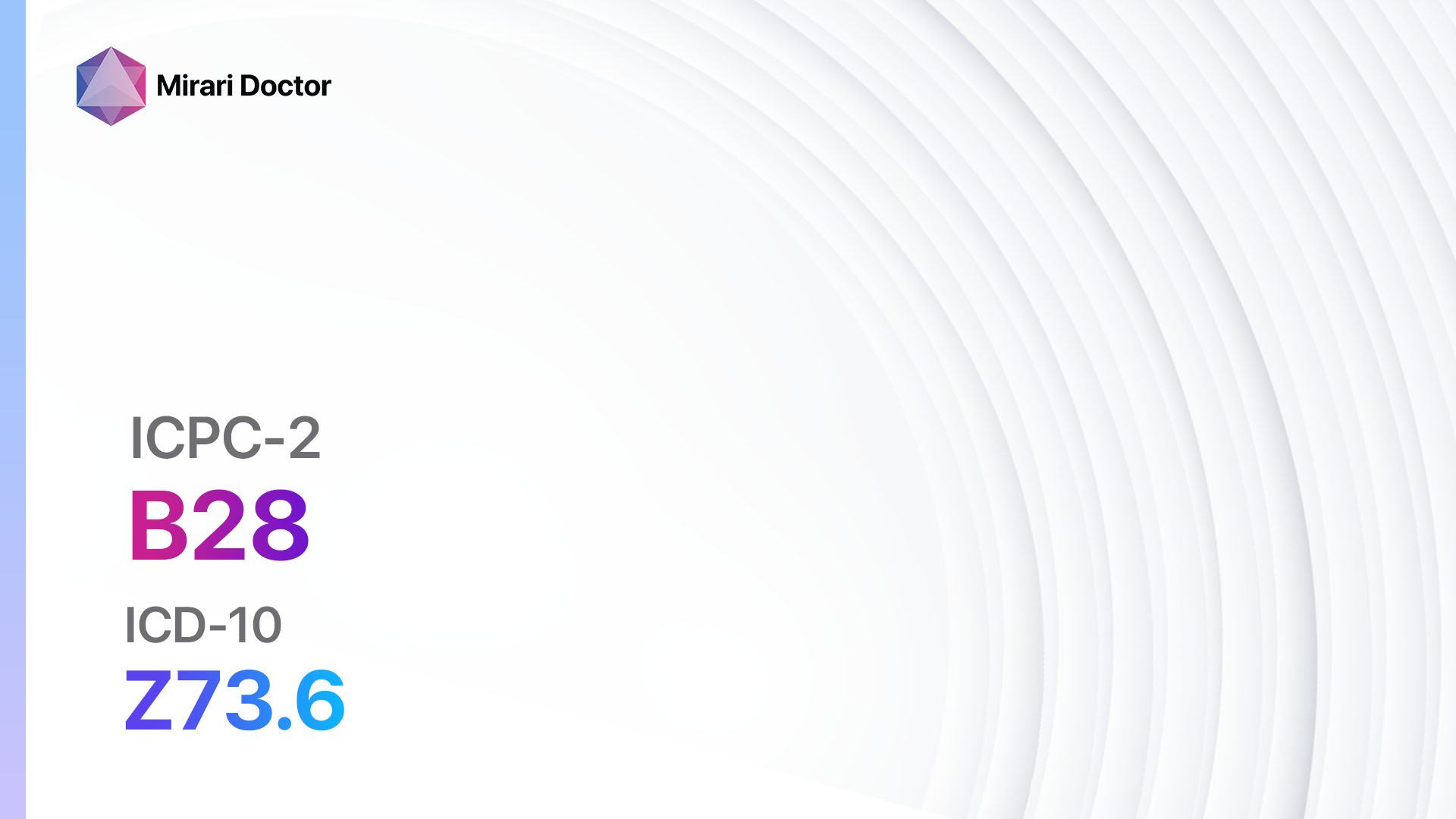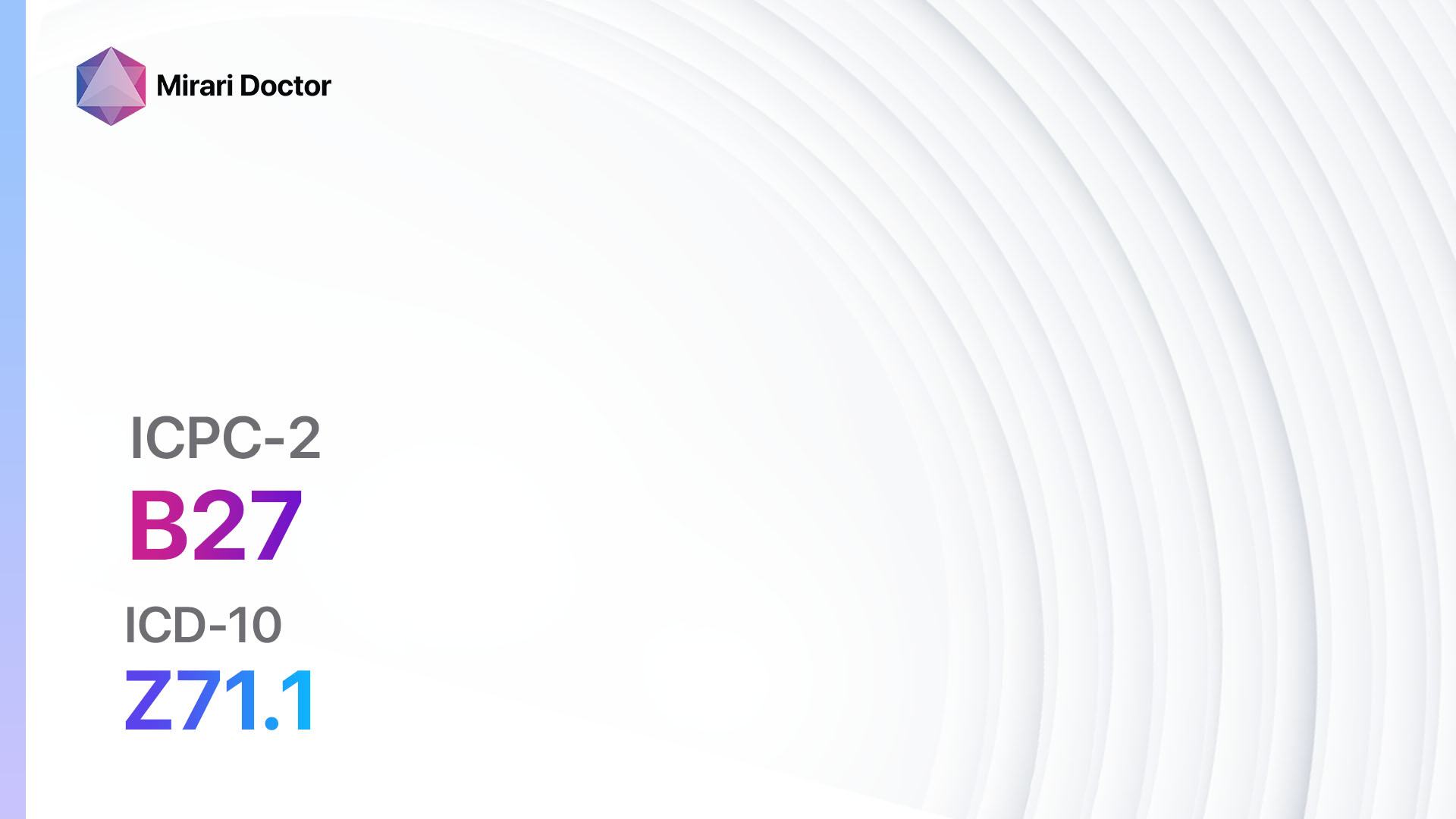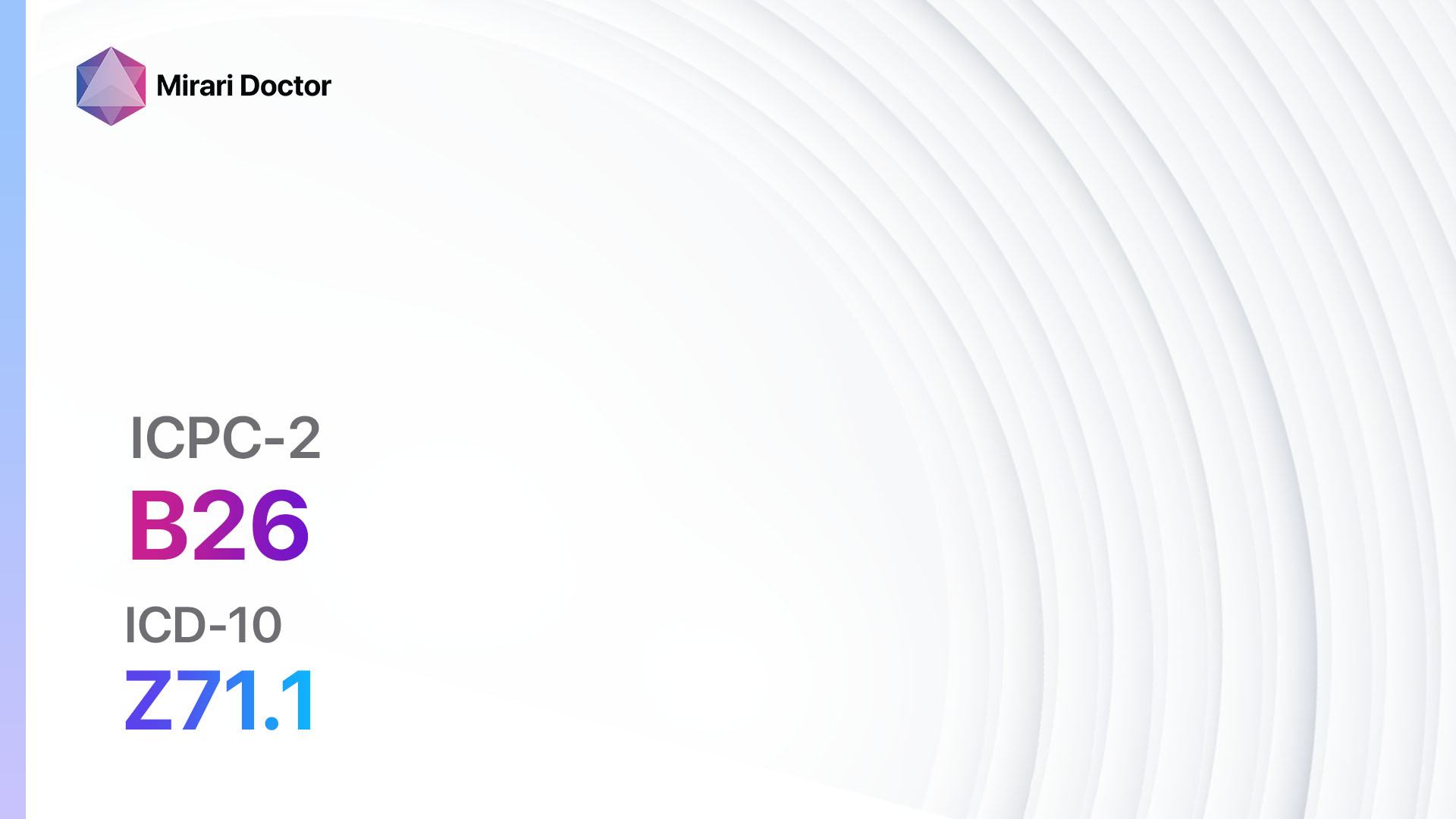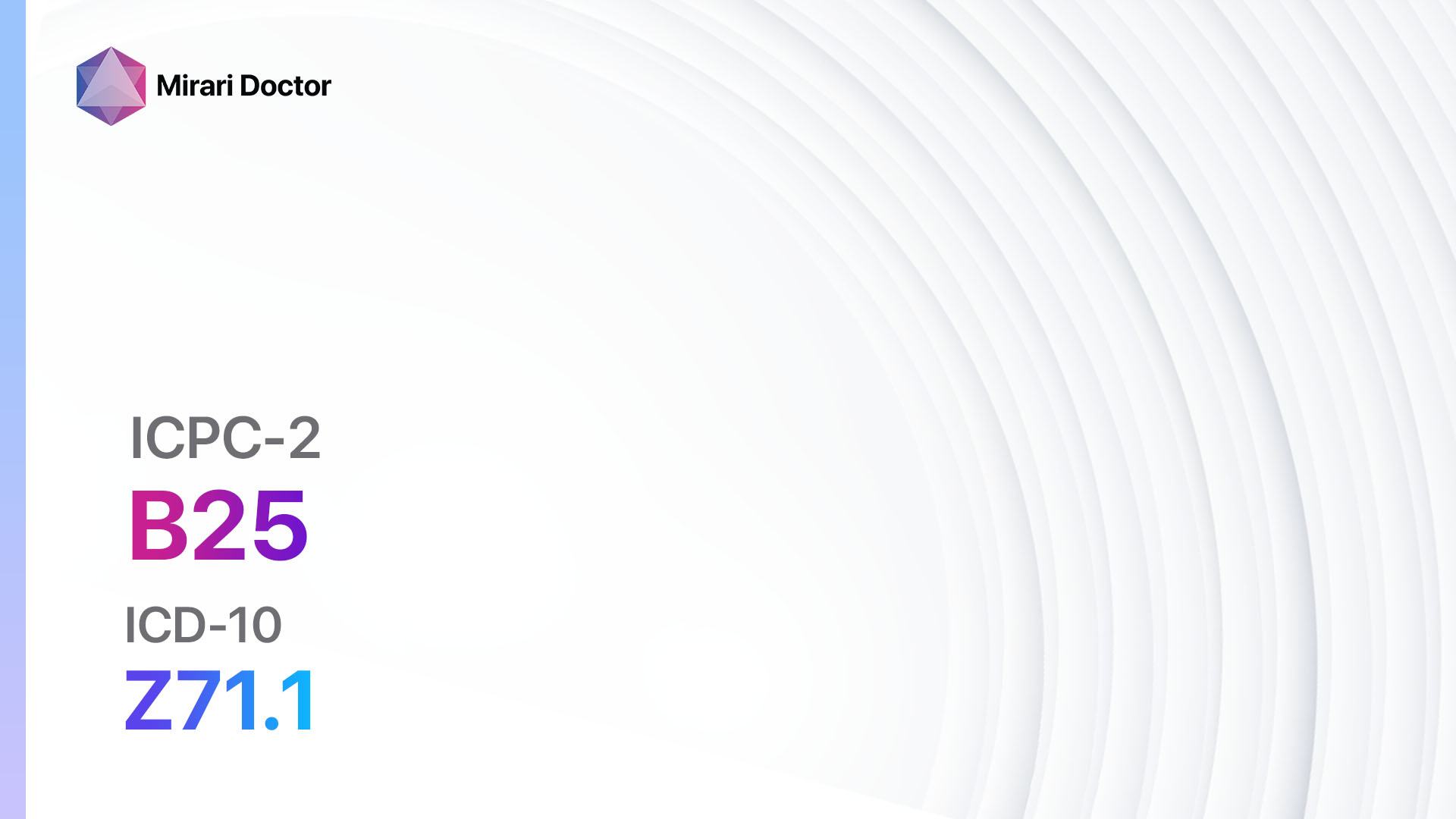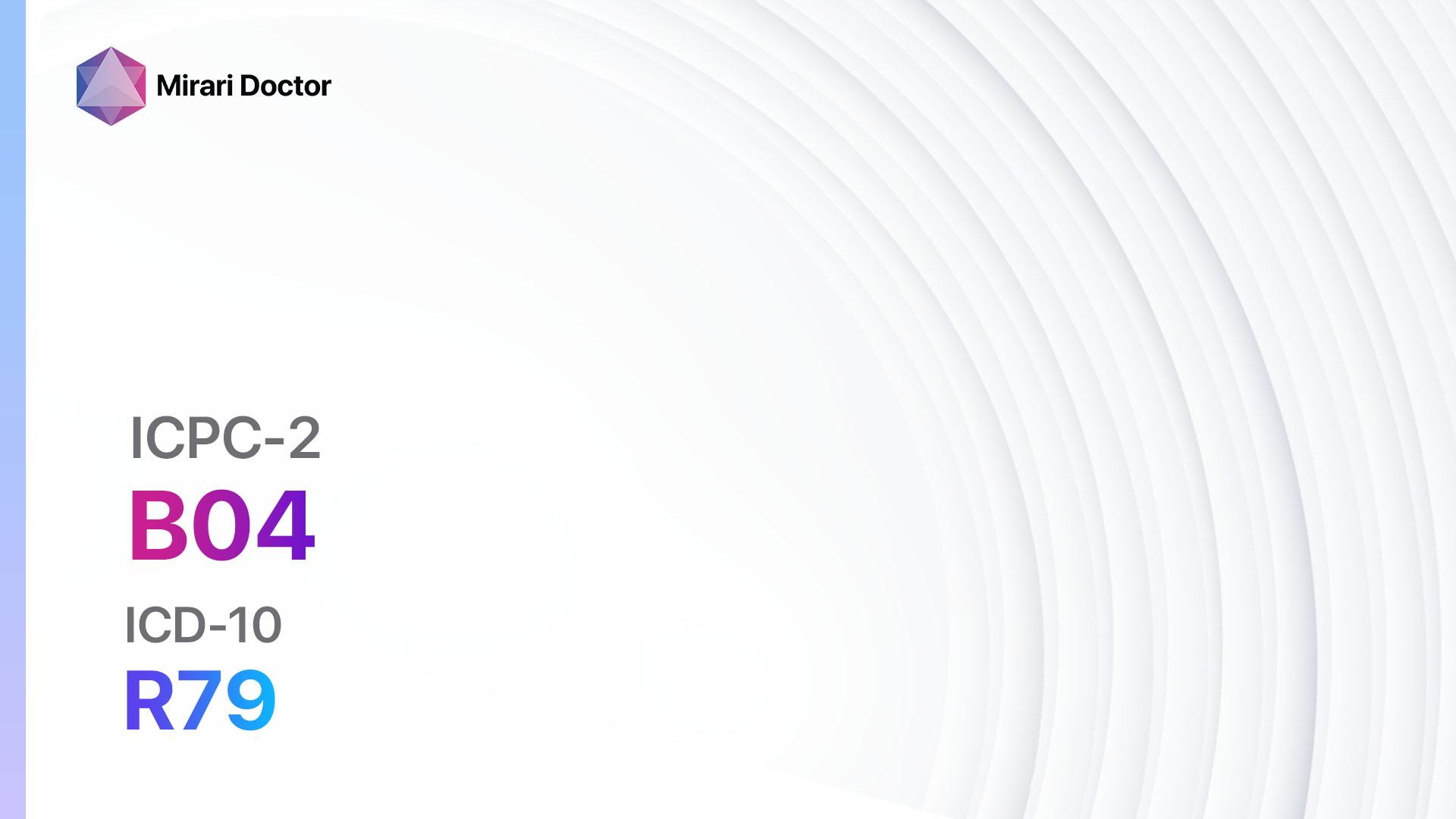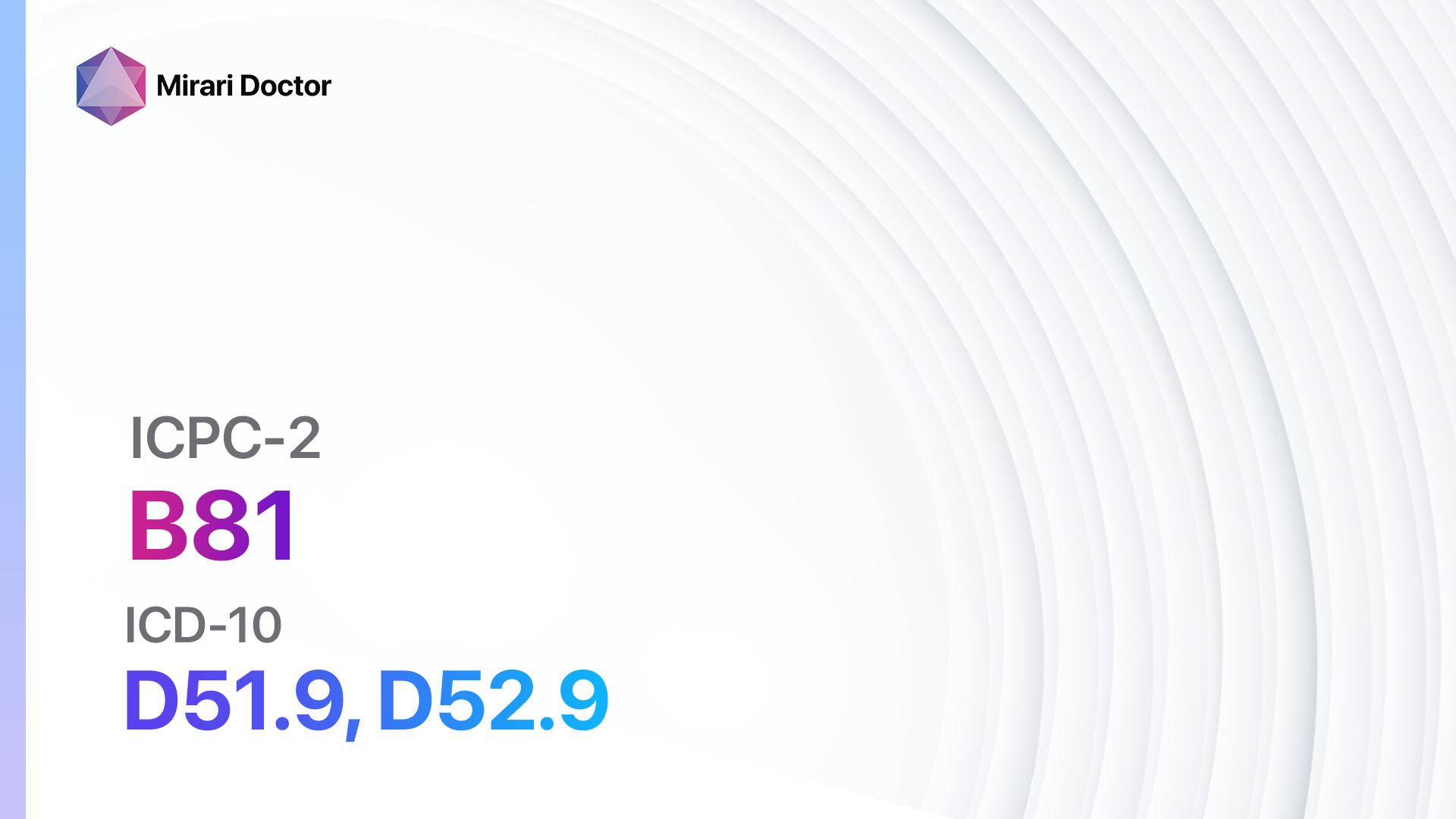
Introduction
Anemia, specifically vitamin B12/folate deficiency anemia, is a condition characterized by a deficiency of vitamin B12 or folate in the body. These essential nutrients are necessary for the production of healthy red blood cells. Anemia can lead to a variety of symptoms and complications, making it important to diagnose and treat promptly[1][2]. The aim of this guide is to provide a comprehensive overview of the diagnostic steps, possible interventions, and patient education for anemia, vitamin B12/folate deficiency.
Codes
- ICPC-2 Code: B81 Anemia, Vitamin B12/folate def.[3]
- ICD-10 Code: D51.9 Vitamin B12 deficiency anaemia, unspecified, D52.9 Folate deficiency anaemia, unspecified[4][5]
Symptoms
- Fatigue: Feeling tired and lacking energy.
- Weakness: Reduced strength and endurance.
- Pale skin: Skin may appear pale or have a yellowish tinge.
- Shortness of breath: Difficulty breathing or feeling breathless.
- Dizziness: Feeling lightheaded or faint.
- Rapid heartbeat: Heart may beat faster than normal.
- Headache: Persistent or recurring headaches.
- Tongue changes: Swollen, smooth, or sore tongue.
- Numbness or tingling: Sensations of pins and needles in extremities.
- Cognitive difficulties: Memory problems or difficulty concentrating[6].
Causes
- Inadequate dietary intake: Lack of foods rich in vitamin B12 or folate.
- Malabsorption: Conditions that affect the absorption of these nutrients in the digestive system.
- Pernicious anemia: Autoimmune condition where the body cannot absorb vitamin B12.
- Medications: Certain medications can interfere with the absorption or utilization of vitamin B12 or folate.
- Alcoholism: Excessive alcohol consumption can lead to deficiencies in these nutrients.
- Pregnancy: Increased demand for vitamin B12 and folate during pregnancy[7].
Diagnostic Steps
Medical History
- Gather information about the patient’s dietary habits, including intake of foods rich in vitamin B12 and folate.
- Ask about any digestive or malabsorption issues, such as Crohn’s disease or celiac disease.
- Inquire about any medications the patient is taking that may affect vitamin B12 or folate levels.
- Assess for symptoms of pernicious anemia or other autoimmune conditions.
- Determine if the patient is pregnant or planning to become pregnant[8].
Physical Examination
- Check for signs of pale skin or yellowish tinge.
- Assess for signs of fatigue, weakness, or shortness of breath.
- Examine the tongue for swelling, smoothness, or soreness.
- Test for numbness or tingling in the extremities.
- Evaluate cognitive function and memory[9].
Laboratory Tests
- Complete blood count (CBC): Measures the number and quality of red blood cells.
- Serum vitamin B12 level: Determines the level of vitamin B12 in the blood.
- Serum folate level: Measures the level of folate in the blood.
- Homocysteine and methylmalonic acid levels: Elevated levels may indicate vitamin B12 deficiency.
- Intrinsic factor antibody test: Detects antibodies that may interfere with the absorption of vitamin B12.
- Schilling test: Determines the body’s ability to absorb vitamin B12[10].
Diagnostic Imaging
- Upper gastrointestinal endoscopy: Used to evaluate the digestive system for malabsorption issues.
- Colonoscopy: Assesses the colon for any abnormalities that may affect nutrient absorption.
Other Tests
- Bone marrow biopsy: Rarely needed, but may be performed if other tests are inconclusive.
- Genetic testing: Used to identify specific genetic mutations that may affect vitamin B12 or folate metabolism.
Follow-up and Patient Education
- Schedule follow-up appointments to monitor response to treatment and adjust interventions as needed.
- Educate the patient about the importance of maintaining a balanced diet rich in vitamin B12 and folate.
- Discuss the potential need for lifelong supplementation or dietary changes.
- Provide resources for support groups or online communities for individuals with anemia.
Possible Interventions
Traditional Interventions
Medications:
Top 5 drugs for Anemia, Vitamin B12/folate deficiency:
- Cyanocobalamin (Vitamin B12) injections:
- Cost: Varies depending on the brand and dosage, ranging from $10 to $100 per injection.
- Contraindications: Hypersensitivity to cyanocobalamin or cobalt.
- Side effects: Mild diarrhea, itching, or rash at the injection site.
- Severe side effects: Anaphylaxis (rare).
- Drug interactions: None reported.
- Warning: Regular monitoring of vitamin B12 levels may be necessary.
- Folic acid tablets:
- Cost: Generic versions can be as low as $5 for a month’s supply.
- Contraindications: Hypersensitivity to folic acid or any component of the tablet.
- Side effects: Rare, but may include nausea, bloating, or flatulence.
- Severe side effects: Allergic reactions (rare).
- Drug interactions: Methotrexate, phenytoin, sulfasalazine.
- Warning: High doses of folic acid may mask vitamin B12 deficiency.
- Iron supplements (if iron deficiency is also present):
- Cost: Varies depending on the brand and dosage, ranging from $5 to $20 for a month’s supply.
- Contraindications: Hemochromatosis, hemosiderosis, or iron overload.
- Side effects: Constipation, nausea, or stomach upset.
- Severe side effects: Allergic reactions (rare).
- Drug interactions: Antacids, tetracycline antibiotics.
- Warning: Iron supplements should be taken on an empty stomach for better absorption.
- Proton pump inhibitors (PPIs) (if acid reflux is present):
- Cost: Generic versions can be as low as $10 for a month’s supply.
- Contraindications: Hypersensitivity to PPIs or any component of the medication.
- Side effects: Headache, diarrhea, or abdominal pain.
- Severe side effects: Clostridium difficile infection (rare).
- Drug interactions: Clopidogrel, warfarin, methotrexate.
- Warning: Long-term use of PPIs may increase the risk of certain infections.
- Antiparasitic medications (if parasitic infection is present):
- Cost: Varies depending on the specific medication, ranging from $10 to $100 for a course of treatment.
- Contraindications: Hypersensitivity to the medication or any component.
- Side effects: Nausea, vomiting, or abdominal pain.
- Severe side effects: Allergic reactions (rare).
- Drug interactions: None reported.
- Warning: Follow the prescribed treatment regimen and complete the full course of medication.
Alternative Drugs:
- Methylcobalamin (Vitamin B12) sublingual tablets: Alternative form of vitamin B12 supplementation.
- Folate-rich foods: Encourage the consumption of foods naturally high in folate, such as leafy greens, legumes, and fortified cereals.
- Iron-rich foods: Include iron-rich foods in the diet, such as lean meats, seafood, and dark leafy greens.
- Probiotics: May help improve gut health and nutrient absorption.
- Digestive enzyme supplements: Can aid in the digestion and absorption of nutrients.
Surgical Procedures:
- In rare cases, surgery may be necessary to correct underlying conditions that affect nutrient absorption.
Alternative Interventions
- Acupuncture: May help improve energy levels and overall well-being. Cost: $60-$120 per session.
- Herbal supplements: Certain herbs, such as nettle leaf or dandelion root, may support healthy blood cell production. Cost: Varies depending on the specific supplement.
- Meditation and stress reduction techniques: Can help improve overall health and well-being. Cost: Varies depending on the specific practice.
- Dietary modifications: Encourage a well-balanced diet rich in vitamin B12 and folate. Cost: Varies depending on food choices and availability.
- Lifestyle changes: Promote regular exercise, adequate sleep, and stress management. Cost: Varies depending on individual preferences and resources.
Lifestyle Interventions
- Dietary changes: Encourage the consumption of foods rich in vitamin B12 and folate, such as lean meats, fish, eggs, leafy greens, and fortified cereals. Cost: Varies depending on food choices and availability.
- Supplementation: Recommend the use of vitamin B12 and folate supplements as needed. Cost: Varies depending on the brand and dosage.
- Regular exercise: Promote physical activity to improve overall health and well-being. Cost: Varies depending on individual preferences and resources.
- Stress management: Encourage stress reduction techniques, such as deep breathing, meditation, or yoga. Cost: Varies depending on the specific practice.
- Adequate sleep: Emphasize the importance of getting enough sleep for overall health and well-being. Cost: Varies depending on individual sleep habits and preferences.
It is important to note that the cost ranges provided are approximate and may vary depending on the location and availability of the interventions. It is recommended to consult with a healthcare professional for personalized treatment options and cost estimates.
Mirari Cold Plasma Alternative Intervention
Understanding Mirari Cold Plasma
- Safe and Non-Invasive Treatment: Mirari Cold Plasma is a safe and non-invasive treatment option for various skin conditions. It does not require incisions, minimizing the risk of scarring, bleeding, or tissue damage.
- Efficient Extraction of Foreign Bodies: Mirari Cold Plasma facilitates the removal of foreign bodies from the skin by degrading and dissociating organic matter, allowing easier access and extraction.
- Pain Reduction and Comfort: Mirari Cold Plasma has a local analgesic effect, providing pain relief during the treatment, making it more comfortable for the patient.
- Reduced Risk of Infection: Mirari Cold Plasma has antimicrobial properties, effectively killing bacteria and reducing the risk of infection.
- Accelerated Healing and Minimal Scarring: Mirari Cold Plasma stimulates wound healing and tissue regeneration, reducing healing time and minimizing the formation of scars.
Mirari Cold Plasma Prescription
Video instructions for using Mirari Cold Plasma Device – B81 Anemia, Vitamin B12/folate def. (ICD-10:D51.9, D52.9)
| Mild | Moderate | Severe |
| Mode setting: 7 (Immunotherapy) Location: 1 (Sacrum) Morning: 15 minutes, Evening: 15 minutes |
Mode setting: 7 (Immunotherapy) Location: 1 (Sacrum) Morning: 30 minutes, Lunch: 30 minutes, Evening: 30 minutes |
Mode setting: 7 (Immunotherapy) Location: 1 (Sacrum) Morning: 30 minutes, Lunch: 30 minutes, Evening: 30 minutes |
| Mode setting: 7 (Immunotherapy) Location: 4 (Heart, Bile & Pancreas) Morning: 15 minutes, Evening: 15 minutes |
Mode setting: 7 (Immunotherapy) Location: 4 (Heart, Bile & Pancreas) Morning: 30 minutes, Lunch: 30 minutes, Evening: 30 minutes |
Mode setting: 7 (Immunotherapy) Location: 4 (Heart, Bile & Pancreas) Morning: 30 minutes, Lunch: 30 minutes, Evening: 30 minutes |
| Mode setting: 7 (Immunotherapy) Location: 7 (Neuro system & ENT) Morning: 15 minutes, Evening: 15 minutes |
Mode setting: 7 (Immunotherapy) Location: 7 (Neuro system & ENT) Morning: 30 minutes, Lunch: 30 minutes, Evening: 30 minutes |
Mode setting: 7 (Immunotherapy) Location: 7 (Neuro system & ENT) Morning: 30 minutes, Lunch: 30 minutes, Evening: 30 minutes |
| Total Morning: 45 minutes approx. $7.50 USD, Evening: 45 minutes approx. $7.50 USD |
Total Morning: 90 minutes approx. $15 USD, Lunch: 90 minutes approx. $15 USD, Evening: 90 minutes approx. $15 USD |
Total Morning: 90 minutes approx. $15 USD, Lunch: 90 minutes approx. $15 USD, Evening: 90 minutes approx. $15 USD |
| Usual treatment for 7-60 days approx. $105 USD – $900 USD | Usual treatment for 6-8 weeks approx. $1,890 USD – $2,520 USD |
Usual treatment for 3-6 months approx. $4,050 USD – $8,100 USD
|
 |
|
Use the Mirari Cold Plasma device to treat Anemia, Vitamin B12/folate def. effectively.
WARNING: MIRARI COLD PLASMA IS DESIGNED FOR THE HUMAN BODY WITHOUT ANY ARTIFICIAL OR THIRD PARTY PRODUCTS. USE OF OTHER PRODUCTS IN COMBINATION WITH MIRARI COLD PLASMA MAY CAUSE UNPREDICTABLE EFFECTS, HARM OR INJURY. PLEASE CONSULT A MEDICAL PROFESSIONAL BEFORE COMBINING ANY OTHER PRODUCTS WITH USE OF MIRARI.
Step 1: Cleanse the Skin
- Start by cleaning the affected area of the skin with a gentle cleanser or mild soap and water. Gently pat the area dry with a clean towel.
Step 2: Prepare the Mirari Cold Plasma device
- Ensure that the Mirari Cold Plasma device is fully charged or has fresh batteries as per the manufacturer’s instructions. Make sure the device is clean and in good working condition.
- Switch on the Mirari device using the power button or by following the specific instructions provided with the device.
- Some Mirari devices may have adjustable settings for intensity or treatment duration. Follow the manufacturer’s instructions to select the appropriate settings based on your needs and the recommended guidelines.
Step 3: Apply the Device
- Place the Mirari device in direct contact with the affected area of the skin. Gently glide or hold the device over the skin surface, ensuring even coverage of the area experiencing.
- Slowly move the Mirari device in a circular motion or follow a specific pattern as indicated in the user manual. This helps ensure thorough treatment coverage.
Step 4: Monitor and Assess:
- Keep track of your progress and evaluate the effectiveness of the Mirari device in managing your Anemia, Vitamin B12/folate def.. If you have any concerns or notice any adverse reactions, consult with your health care professional.
Note
This guide is for informational purposes only and should not replace the advice of a medical professional. Always consult with your healthcare provider or a qualified medical professional for personal advice, diagnosis, or treatment. Do not solely rely on the information presented here for decisions about your health. Use of this information is at your own risk. The authors of this guide, nor any associated entities or platforms, are not responsible for any potential adverse effects or outcomes based on the content.
Mirari Cold Plasma System Disclaimer
- Purpose: The Mirari Cold Plasma System is a Class 2 medical device designed for use by trained healthcare professionals. It is registered for use in Thailand and Vietnam. It is not intended for use outside of these locations.
- Informational Use: The content and information provided with the device are for educational and informational purposes only. They are not a substitute for professional medical advice or care.
- Variable Outcomes: While the device is approved for specific uses, individual outcomes can differ. We do not assert or guarantee specific medical outcomes.
- Consultation: Prior to utilizing the device or making decisions based on its content, it is essential to consult with a Certified Mirari Tele-Therapist and your medical healthcare provider regarding specific protocols.
- Liability: By using this device, users are acknowledging and accepting all potential risks. Neither the manufacturer nor the distributor will be held accountable for any adverse reactions, injuries, or damages stemming from its use.
- Geographical Availability: This device has received approval for designated purposes by the Thai and Vietnam FDA. As of now, outside of Thailand and Vietnam, the Mirari Cold Plasma System is not available for purchase or use.
References
- Stabler SP. Vitamin B12 deficiency. N Engl J Med. 2013;368(2):149-160. doi:10.1056/NEJMcp1113996
- Green R, Datta Mitra A. Megaloblastic Anemias: Nutritional and Other Causes. Med Clin North Am. 2017;101(2):297-317. doi:10.1016/j.mcna.2016.09.013
- ICPC-2 Code: B81 Anemia, Vitamin B12/folate def. https://miraridoctor.com/b81/
- ICD-10 Code: D51.9 Vitamin B12 deficiency anaemia, unspecified. https://www.icd10data.com/ICD10CM/Codes/D50-D89/D50-D53/D51-/D51.9
- ICD-10 Code: D52.9 Folate deficiency anaemia, unspecified. https://www.icd10data.com/ICD10CM/Codes/D50-D89/D50-D53/D52-/D52.9
- Langan RC, Goodbred AJ. Vitamin B12 Deficiency: Recognition and Management. Am Fam Physician. 2017;96(6):384-389.
- Daru J, Allotey J, Peña-Rosas JP, Khan KS. Serum folate and vitamin B-12 status in pregnancy and their associations with pregnancy outcome: a systematic review and meta-analysis. Nutrients. 2017;9(12):1351. doi:10.3390/nu9121351
- Devalia V, Hamilton MS, Molloy AM; British Committee for Standards in Haematology. Guidelines for the diagnosis and treatment of cobalamin and folate disorders. Br J Haematol. 2014;166(4):496-513. doi:10.1111/bjh.12959
- Hunt A, Harrington D, Robinson S. Vitamin B12 deficiency. BMJ. 2014;349:g5226. doi:10.1136/bmj.g5226
- Aslinia F, Mazza JJ, Yale SH. Megaloblastic anemia and other causes of macrocytosis. Clin Med Res. 2006;4(3):236-241. doi:10.3121/cmr.4.3.236
Related articles
Made in USA


